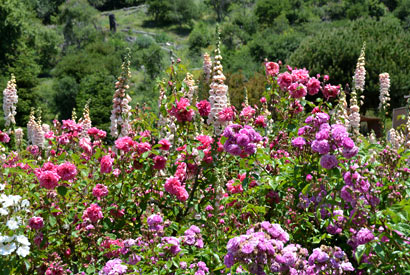A wild summer at the Botanical Garden
Visitors to the UC Botanical Garden this summer are enjoying an abundance of wildlife, including baby raccoons, a profusion of black and orange caterpillars and young foxes.

July 15, 2014
Visitors to the UC Botanical Garden this summer are enjoying an abundance of wildlife: three baby raccoons cavorting in the sunshine, gray fox kits lounging about and an explosion of colorful caterpillars with their butterfly parents.
The garden has already been drawing a steady stream of people curious about the rare Puya raimondii plant, which is bursting forth with hundreds of white and green flowers on a stalk about 21 feet tall (as of Monday, July 14, and it’s still growing). Its sweet nectar lures hummingbirds as well as bees.
But even before visitors stroll deep enough into the garden to observe the Puya, they may be treated to several other special sights.
Closest to the park entrance on Centennial Drive, three baby raccoons have been seen throughout the day playing in the bushes.
Garden Director Paul Licht acknowledges that it may be hard to appreciate raccoons encountered scavenging in the backyard at night, but these little guys are downright adorable.
Originally, there were four, but one disappeared along with the mother, according to garden officials. A video of the creatures is online.
A profusion of bright orange and black caterpillars are easily seen in the Redwood Grove and near the Oak Knoll in the California area. They are the larvae of the Black Pipevine Swallowtail butterfly, which lays its eggs exclusively on pipevine plants (Aristolochia californica). Many of the butterflies can be seen throughout the garden.

The caterpillar larvae of the black pipevine swallowtail butterfly
“The caterpillars are especially big and obvious and lovely,” says Sally Levinson, a self-described “caterpillar lady” who leads garden visits to investigate its caterpillars and butterflies.
She notes that the Black Pipevine Swallowtail butterfly is the largest and most conspicuous of the Botanical Garden’s many butterflies. Levinson also points out that the garden features several large patches of pipevine, the only food that the caterpillars consume. Each species of butterfly has its own favorite favorite kind to plant to feed on, she says, and in the case of Pipevine Swallowtails, it is pipevine.
The downside is for birds, as the caterpillars and butterflies are often noxious to their avian friends because they carry sap from the Aristolochia.

The black pipevine swallowtail butterfly
Other wildlife easily seen at the garden are fence lizards, tadpoles in the ponds and an occasional newt.
Information about the UC Botanical Garden is online.
The garden’s next butterfly walk is 3-4 p.m., Tuesday, July 22. Butterfly walks take place on the fourth Tuesday of each month in April through October..